There's nothing betterthan a good friend, that special person who will lend a hand without expecting anything in return.In racing, the best friends an organization can have are the people who volunteer their services todo the countless tasks necessary to get the show on the road. The thousands of people who volunteerto help CART are an absolute lifeline for the sanctioning body on race weekends.
Volunteers are almost as essential to the staging of a CART event as the drivers and the cars. Without this dedicated band of people who give of their time, and spend their own money, a race weekend could not be held. Everything from setting up the pits, to teching the entries, to putting out the fires, to checking the tires, and most things in between is in part done byenthusiastic workers who donate their energy to a sport they love.
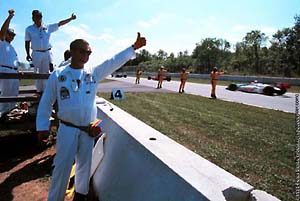 Volunteerism in CART can take several forms. There are those who pitch in as members of local organizations, such as Wisconsin Fans for Auto Racing; R.E.V.'s, the Cleveland Grand Prix volunteer organization; or REVV, Race Event Volunteers of Vancouver. These are usually local people who help to stage a CART event in their hometown. Of course, one of the most famous organizations is the Long Beach Grand Prix's Committee of 300, the folks in the red jackets who make the Long Beach event happen every year. Rena Shanaman, CART's VP of Promoter Relations, set up the volunteer organization for the Detroit Grand Prix, giving the CART organization a deep appreciation for what volunteers contribute.
Volunteerism in CART can take several forms. There are those who pitch in as members of local organizations, such as Wisconsin Fans for Auto Racing; R.E.V.'s, the Cleveland Grand Prix volunteer organization; or REVV, Race Event Volunteers of Vancouver. These are usually local people who help to stage a CART event in their hometown. Of course, one of the most famous organizations is the Long Beach Grand Prix's Committee of 300, the folks in the red jackets who make the Long Beach event happen every year. Rena Shanaman, CART's VP of Promoter Relations, set up the volunteer organization for the Detroit Grand Prix, giving the CART organization a deep appreciation for what volunteers contribute.
There are others who, as unpaid volunteers, assist directly under the auspices of CART in areas such as timing and scoring, technical, and safety. At the third level are those who volunteer their time and talent, but have their travel expenses and a per diem paid by CART. Each group is vital to the success of a race weekend.
Local race event groups offer fans a chance to get "inside," to experience the sights and sounds of racing first hand.
"The best thing is working within the Paddock area and interacting with the team members and being part of the "team," said Brian Pratt, of REVV. "I was part of the whole CART experience."
Tony Fossett, who volunteers at Belle Isle and Cleveland, has found that "the best thing about the job, hands down, is meeting other volunteers. It's such a good social atmosphere, in fact, that I don't consider up-close access to the race cars to be that big of a deal anymore!"
If there is a downside to his job as a ticket taker at Gate 3, Belle Isle, it is that sometimes he has to be a bad guy.
"Someone always has a sob story about how the dog ate their tickets or some such, and couldn't I just let them in," said Fossett.
Even though he has moved to NASCAR country (North Carolina), Tony still returns to work the Detroit Grand Prix every year.
Terry Kettering, a board member of Cleveland's R.E.V's, started out as a volunteer in the Championship Racing Magazine booth. He now helps to organize almost 600 people who pitch in to assist in staging the race at the Burke Lakefront Airport. Their efforts for the 1999 event started in February. Volunteers, some of whom spend hundreds of hours working for no pay, are rewarded with meals during the race weekend, T-shirts, pins and a party when the event is over, as well as other bonuses.
"Most people come back year after year. We try to feed them well, and we have a raffle during the party on Sunday night with as many as 200 different items that they can win," said Kettering. "Prizes include goodies donate by the CART teams."
It is often these local organizations that staff the Media Centers at the various events. Chuck Obendorf has been the Media Center Manager for the Grand Prix of Cleveland for the past six years.
One of his perks is the task of picking up the race winner right after the on-track TV interviews and transporting them to the victory ceremony and then on to the press conference. Obendorf stated, "I have met some really great people doing this, including Gil de Ferran, Jacques Villeneuve, Alex Zanardi and Bryan Herta. It is exciting to be able to talk to them one on one, if only for the few minutes they ride in my golf cart."
He highly recommends getting involved, as he stated, "Once you are around the excitement, noise, and spectacle of all this, it gets into your blood."
Nancy Chuck, a founding member of Wisconsin Fans for Auto Racing agrees with Obendorf. Her organization staffs the Media Center at the Milwaukee Mile.
"The best thing is the chance to be a small part of the racing scene, even if it is on 'the fringe.' Occasionally you get a chance to meet drivers," said Chuck. "But just knowing that we are providing a needed service and doing a good job is important. And yes, many of the media and team reps do thank us at the end of the weekend for a job well done-that's all the recognition/validation you can ask for."
Many other volunteer jobs are available directly under the supervision of CART itself. One such area is Timing and Scoring. At each race, human timing and scoring is done to back up the computerized system. In the event of a glitch, or a question, there are written records that can be used.
Jill Lyon of Indianapolis has volunteered in this area for twelve years, and usually attends eight to ten races each season. Her job requires intense concentration during a race, as she explained, "On a one mile oval, you have less than 20 seconds to score the car, hopefully 200 times if your car stays in the race. Everyone has to concentrate on his or her individual car, so we have to be quiet. On road courses, we have to hold that concentration for a minute and a half or more."
Jill enjoys meeting people from different parts of the country and the world at the venues, adding, "I send out more out-of-town Christmas cards than in-town. Sometimes we have dinner with people from three or four different states. What do we talk about? Racing of course!"
Paul Bell of Miami agrees with Lyon. He has been a Timing and Scoring volunteer since 1991, and works 2-3 races per year.
"I love being involved in the racing," said Bell. "My father was a driver in SCCA and IMSA when I was a teen, and from then on I never could stand to just pay for the ticket and sit in the stands…I wanna help! Not only that, I've met some great folks…and the passes are nice too."
Linda Foster, Craig Newman, and Bill Spellerberg of St. Louis found that their involvement with local and regional SCCA races led to CART timing and scoring as well. The three volunteer at six or seven CART events during the season and have done so for more than 10 years.
Foster explained that one of the greatest challenges is, "working on the shoestring budget of a volunteer. Finding reasonable accommodations can be difficult."
But like the others, they find that the people are what make the job so enjoyable.
Volunteer course workers fall under the direction of Gary Barnard, CART's Chief Course Observer. This is a job which Mike Herman of Portland, Oregon does some five or six times a year. It takes four to seven people to staff a corner, rotating between positions: blue flagger, yellow flagger, communications, and first responder. Course observers are critical to the safety of the drivers and the spectators, as communicators relay vital information to race control regarding incidents to aid the rescue and safety crews in doing their jobs.
"The people on Communications need to be very alert to everything going on and have to be able to relay vital information both quickly and accurately," Herman explained.
When an incident occurs on the track, course observers sometimes go onto the racing surface to assist. These decisions to go into harm's way are never made lightly. First responders never enter the track without the approval of their turn marshal. Gary Barnard has stressed the importance of having a reason to go to a car in trouble.
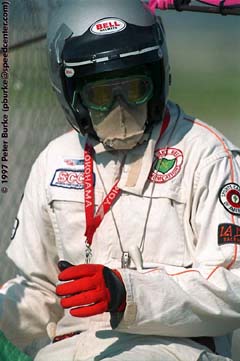 "Gary is always very adamant about keeping ourselves and our co-workers safe," Herman noted. "A motto he has told us over and over again when working response is to 'know what you are going to do when you get to the car!' He gets angry when he sees someone go to a car and just stand there."
"Gary is always very adamant about keeping ourselves and our co-workers safe," Herman noted. "A motto he has told us over and over again when working response is to 'know what you are going to do when you get to the car!' He gets angry when he sees someone go to a car and just stand there."
Most corner workers come to CART with some racing experience, usually from the ranks of SCCA. This gives them some training, and allows them to have good judgment when events occur on the track.
In spite of the exposure to the elements, Herman has found the job most satisfying.
"There is nothing more exciting than the first time you hear a grandstand full of fans clap in appreciation of us getting a wreck or incident cleared up quickly so the racing can resume," Herman explained.
Another satisfied volunteer is Louis Galmarini of Cleveland. He has worked Fire/Safety at Cleveland and Mid-Ohio for the past six years. Galmarini got into his job purely by accident. He was given a free pit/paddock pass for the Cleveland race, and says, "we went strictly because of the free tickets and no other reason."
When he ran into a friend who was working Fire/Safety as a volunteer he was asked if he would like to do the same. Galmarini wasn't really interested, but said he would think about it. Suddenly he changed his mind.
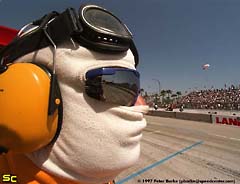 "I was standing in the pits just about two feet from the wall when someone (I think it was Paul Tracy) came down off the jacks and took off at about 14,000 rpm," Galmarini said. "They tell me that I had the 'stupidest' grin on my face, along with pieces of rubber down to my waist, (where the wall started). Finding my friend through the smoke I asked, 'Where's that trailer at?!' I was hooked. I was in heaven the rest of the weekend and have worked Cleveland ever since."
"I was standing in the pits just about two feet from the wall when someone (I think it was Paul Tracy) came down off the jacks and took off at about 14,000 rpm," Galmarini said. "They tell me that I had the 'stupidest' grin on my face, along with pieces of rubber down to my waist, (where the wall started). Finding my friend through the smoke I asked, 'Where's that trailer at?!' I was hooked. I was in heaven the rest of the weekend and have worked Cleveland ever since."
The Candeloro family of New Jersey represents two of the levels of CART volunteers. Carol and Joe started doing fire protection at the Meadowlands races and when that venue no longer had an event they volunteered for other positions. They started small, doing two races their first year, working up to as many as 11. The out-of-pocket cost to them was astronomical, but it was something they both loved.
"It's always your hope as a volunteer, to become an official, to move up the ladder," Carol Candeloro said.
This has now happened to part of the family, as Joe has become a traveling official for CART. His expenses are paid, but Carol continues to volunteer, paying her own way.
"I usually work the valve trailer," she explained. "We are responsible for the pop-off valves. We inspect and clean them, and randomly number them for each car. We give them out before each practice and qualifying session and collect them afterward. A record book of valves is maintained, making sure the right valve is going to the right car. It also lets us know that each valve has come back in."
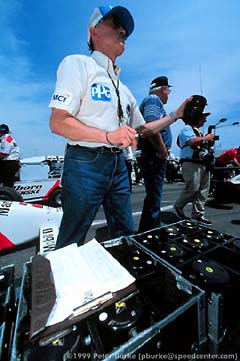 Pop-off valves fall under the jurisdiction of CART's Technical Coordinator, Dick Perry. Perry is also a volunteer who uses all of his vacation time and unpaid days as well to attend every race. He oversees some 20 traveling officials and 50 volunteers at each venue.
Pop-off valves fall under the jurisdiction of CART's Technical Coordinator, Dick Perry. Perry is also a volunteer who uses all of his vacation time and unpaid days as well to attend every race. He oversees some 20 traveling officials and 50 volunteers at each venue.
"The nature of auto racing is volunteering," said Perry. "That is always the way it has been in this country."
Perry maintains a staff of 20 traveling officials to ensure constancy and experience.
"The teams wouldn't like a lack of continuity, and it wouldn't be fair to them if we didn't have consistency in the technical area," he said.
Working with a database of about 500 volunteers, Perry secures the necessary staffing for all 20 CART events. He starts organizing for the new season in December of the preceding year, communicating by letter with each person on his list.
"One person may do one event, or ten events," Perry noted. "We get our people from SCCA, Winners Circle, friends, that's how we go about building volunteers. We've had everything from morticians to switch-board operators."
Overseas races can be a bit problematic, due to language barriers and inexperience. Australia presents no such difficulties, as he has a good base of people there, but he adds two additional paid officials for Brazil and Japan.
This season's newest event in Chicago presented a unique challenge.
"Everybody wanted to go to Chicago," Perry explained. "It's a new event. I had too many people, so I had to choose volunteers on the number of days they were able to attend. I took four days over those who could only attend three."
So, race fans, the next time you're at an event, or watching one on television, those busy folks in the background just might be an attorney, a mechanical engineer, a systems analyst, or work in accounts payable. They're giving up their vacation days, and often spending their own money to help stage the race that brings you so much pleasure.
Just why do they do it?
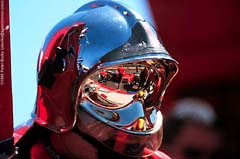 "Racing has provided so much enjoyment to me," said Nancy Chuck. "Volunteering has allowed me to give something back to the sport that has given me so much, and it has allowed me to be a part of the sport I love. It's mostly about people: the people you work with, the people who work with you, and the friends you make along the way. It always feels like you get back more than you give."
"Racing has provided so much enjoyment to me," said Nancy Chuck. "Volunteering has allowed me to give something back to the sport that has given me so much, and it has allowed me to be a part of the sport I love. It's mostly about people: the people you work with, the people who work with you, and the friends you make along the way. It always feels like you get back more than you give."